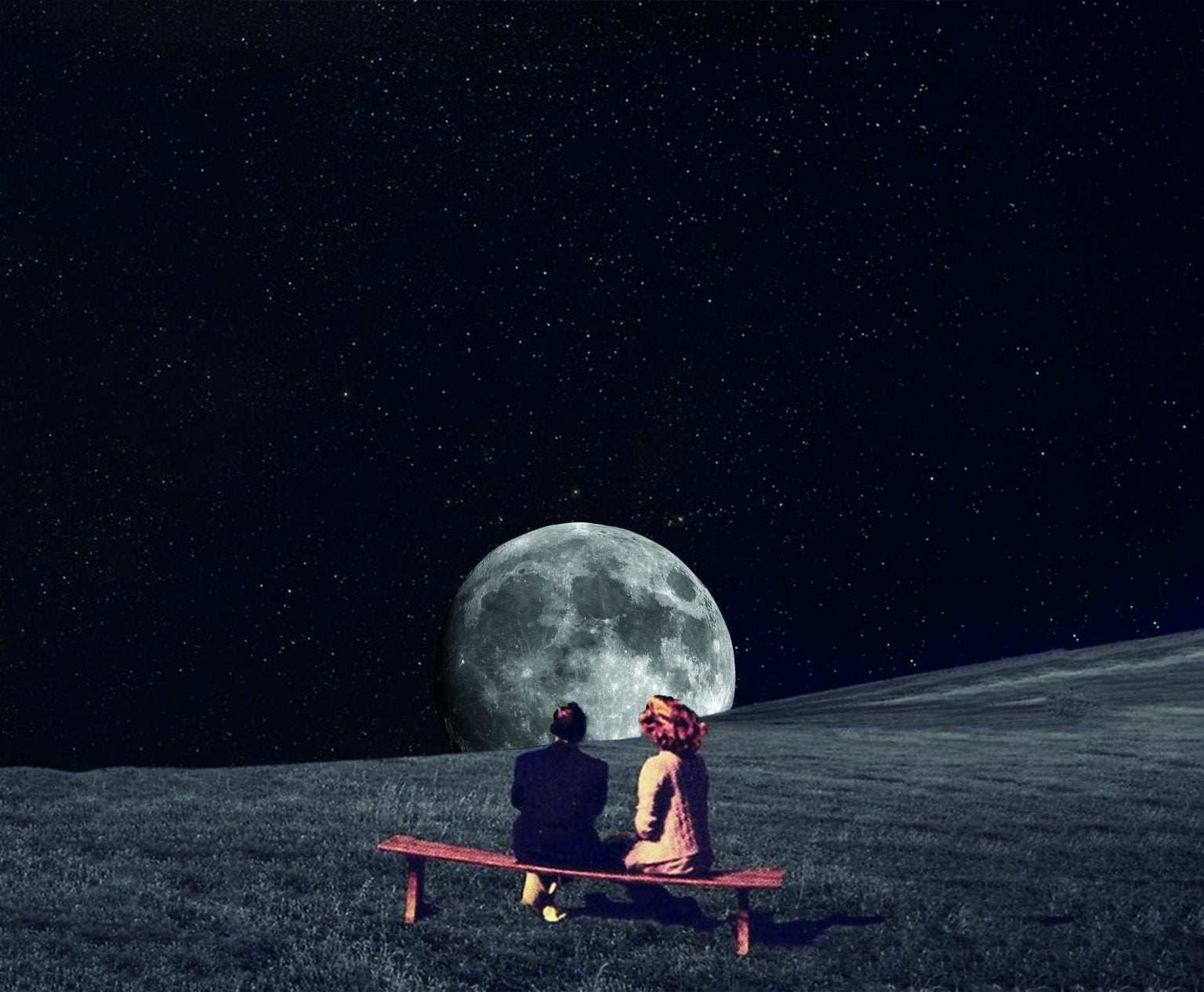Moons in our solar system come in far more varieties than our single familiar neighbor in the night sky. Earth has just one, but across the solar system there are over 200—ranging from tiny captured rocks to worlds so complex they could almost be planets in their own right. These moons in our solar system are not just numbers on a list; each one tells a story about how planets form and evolve.
If you’d like to spark a child’s curiosity about all this, sometimes the best starting point isn’t a telescope but something they can actually touch. The Uncle Goose Planet Blocks and the Uncle Goose Moon Phase Blocks are perfect for that—beautiful wooden building blocks that turn planets and lunar phases into play.
They’re the kind of toys where stacking turns into memorizing, and play naturally spills over into questions about the universe. A small way to bring the solar system down to Earth, and an early step toward appreciating the diversity of moons in our solar system.
Table of Contents
Why Moons in Our Solar System Deserve Their Own Spotlight?
Mercury and Venus travel alone, but nearly every other planet has an entourage. Saturn and Jupiter lead the pack, each orbited by dozens of satellites, some larger than Mercury itself. Even distant Pluto and many asteroids keep small moons as companions, showing just how widespread moons in our solar system really are.
These moons in our solar system aren’t just cold, dead stones. Some are stretched into strange shapes, some are cloaked in thin atmospheres, and others hide oceans beneath icy crusts. They reveal the processes that shaped the planets, sometimes born from swirling discs of gas and dust, sometimes captured from elsewhere and locked into orbit. Together, the moons in our solar system make it feel less like a family of planets and more like a sprawling community of worlds.
To picture this variety more easily, you can watch Yeti Dynamics’s If the Moon were replaced with some of our planets video below. It’s the kind of visualization of moons in our solar system you don’t see every day!
Some years ago, I bought myself a decent telescope and ended up spending countless nights just staring at the Moon—until the poor thing broke down. Around the same time, I also stumbled upon the trickiest Moon-themed puzzle I’ve ever touched; it kept me busy for three whole months. While working on it, I found myself diving deep into NASA’s archives, learning more and more about the moons scattered across our solar system.
That little obsession grew into this piece: a list of my twenty favorite moons, chosen not just for their science but for their beauty.
And since no Moon story feels complete without a nod to Apollo 11, I also pulled together forty original newspaper front pages showing how the world greeted humanity’s first steps on the lunar surface.
Enjoy the trip.
Areil – Uranus’s Moon

Ariel is the brightest and one of the most fascinating moons of Uranus. Its surface looks surprisingly young compared to its neighbors, covered not with huge scars but with a network of canyons, valleys, and ridges carved by ancient geological activity. Scientists believe that water mixed with ammonia may once have flowed across its surface, leaving behind channels that make Ariel look a bit like a frozen world in motion.
Unlike heavily cratered moons, Ariel shows evidence that big impacts were erased over time—hinting that internal forces reshaped its landscape. This makes Ariel not just a passive rock circling Uranus but a place with a history of change and possibly even hidden secrets beneath its icy shell.
Callisto – Jupiter’s Moon

Callisto is the outermost of Jupiter’s four Galilean moons and one of the most heavily cratered worlds in the solar system. Its battered surface has barely changed for billions of years, preserving a record of ancient impacts like a cosmic time capsule. Unlike the geologically active Europa or Io, Callisto appears quiet and stable, with little internal activity reshaping its face.
Yet beneath that scarred crust, scientists suspect something surprising: a vast salty ocean hidden deep below the ice. If true, this makes Callisto not just a relic of the past but also a potential home for microbial life. A world that seems silent on the outside may still hold secrets within.
Charon – Pluto’s Moon

Charon is Pluto’s largest moon, so big that the two worlds actually form a kind of double planet system. Instead of Pluto being the clear center of gravity, both Pluto and Charon orbit a point in space that lies between them—a cosmic dance unlike anything else in our solar system.
Charon’s surface is a patchwork of cliffs, canyons, and strange dark regions. Its northern hemisphere features a huge reddish stain, likely the result of gases escaping from Pluto and settling on Charon’s ice. Even more fascinating, there’s evidence that Charon once had an internal ocean that froze solid, cracking its surface open into vast canyons that stretch farther than the Grand Canyon.
Dione – Saturn’s Noon

Dione may not be Saturn’s largest moon, but it’s one of its most intriguing. At first glance, Dione looks like a battered, icy sphere covered in craters. But a closer look reveals long, bright “wispy streaks” that stretch across its surface. These striking features aren’t just decorative—they’re icy cliffs formed by ancient tectonic fractures, hinting that Dione once experienced powerful geological shifts.
What makes Dione even more interesting is what might be hiding beneath its frozen shell. Data from the Cassini spacecraft suggests that Dione could harbor a subsurface ocean, much like its more famous neighbor Enceladus. If true, this quiet little moon could be far more alive than it appears, carrying secrets beneath its icy crust.
Enceladus – Saturn’s Moon

Enceladus is one of the most dazzling discoveries of the Cassini mission. This small, icy moon of Saturn reflects almost all the sunlight that hits it, making it shine brilliantly against the darkness of space. But what truly sets Enceladus apart is what’s happening beneath its surface. From cracks near its south pole, towering plumes of water vapor and ice shoot into space—evidence of a vast subsurface ocean hidden below the crust.
These geysers don’t just make Enceladus spectacular to watch; they also fuel Saturn’s E-ring, spreading fresh particles across the planet’s orbit. Even more exciting, scientists have found organic molecules in the plumes, raising the possibility that this frozen world could support microbial life in its hidden ocean. Enceladus has quickly become one of the most promising places to search for life beyond Earth.
Europa – Jupiter’s Moon

Europa is one of the most captivating moons in the solar system. At first glance, its surface looks like a smooth sheet of ice, crisscrossed with reddish cracks and ridges. Unlike heavily cratered worlds, Europa’s icy crust seems relatively young, constantly reshaped by internal forces.
What makes Europa extraordinary is what lies beneath: a vast global ocean hidden under tens of kilometers of ice. This ocean may contain more water than all of Earth’s seas combined. The cracks and dark streaks on Europa’s surface suggest that water and heat from below continue to interact with the frozen shell above. Combined with the discovery of possible water plumes erupting into space, Europa has become one of the prime candidates in the search for extraterrestrial life.
Ganymede – Jupiter’s Moon

Ganymede isn’t just Jupiter’s largest moon—it’s the largest moon in the entire solar system, even bigger than the planet Mercury. With its own magnetic field, something no other moon possesses, Ganymede behaves less like a typical satellite and more like a small planet in its own right.
Its surface is a striking mix of two terrains: darker, heavily cratered regions that speak to an ancient past, and brighter, grooved areas shaped by tectonic forces that pulled the icy crust apart. This contrast makes Ganymede a geological puzzle, hinting at a history of shifting and reshaping.
Beneath its frozen shell, scientists believe a vast salty ocean exists, layered between sheets of ice. If true, this hidden sea could be another potential home for life, making Ganymede not only the largest moon but also one of the most fascinating.
Iapetus – Saturn’s Moon

Iapetus is one of Saturn’s strangest moons, famous for its dramatic “yin-yang” appearance. One hemisphere is as bright as freshly fallen snow, while the other is as dark as coal. This sharp contrast makes Iapetus look like a cosmic two-tone sphere drifting through space. Scientists think the darkness comes from material swept up from outer moons, coating one side while the other remains reflective and icy.
But the oddities don’t stop there. Iapetus also has a giant equatorial ridge—an enormous chain of mountains that wraps almost all the way around the moon’s middle. In some places, the ridge rises over 12 miles (20 kilometers) high, making it one of the tallest known mountain ranges in the solar system. The origin of this feature remains a mystery, adding to Iapetus’s reputation as one of the most peculiar moons ever discovered.
Io – Jupiter’s Moon

Io is the most volcanically active world in the solar system, a place where the landscape is constantly being reshaped by eruptions. Instead of craters, its surface is dotted with hundreds of volcanoes, some spewing lava fountains that rise dozens of miles high. These eruptions are powered by tidal heating: as Io orbits Jupiter, the planet’s immense gravity (along with the pull of nearby moons Europa and Ganymede) flexes Io’s interior, generating enough heat to melt rock.
The result is a world that looks almost alien, painted in yellows, reds, and blacks from sulfur and lava flows. Io is both beautiful and violent—a place where the ground never seems to rest. Despite its chaotic surface, Io provides scientists with a natural laboratory to study volcanic processes on a planetary scale.
Mimas – Saturn’s Moon

Mimas is often called the “Death Star moon” because of its uncanny resemblance to the famous space station from Star Wars. The reason is a single massive impact crater named Herschel, which dominates one side of the moon. The crater is over 80 miles (130 kilometers) wide—nearly a third of Mimas’s diameter—making it one of the most dramatic impact features in the solar system.
Despite its striking appearance, Mimas is a quiet world. It’s made mostly of ice with a little rock, and its heavily cratered surface suggests it has been geologically inactive for billions of years. Still, recent studies hint at something unexpected: Mimas might conceal a subsurface ocean, hidden beneath its icy crust, making this seemingly simple moon far more mysterious than it looks.
Miranda – Uranus’ Moon

Miranda is one of the smallest of Uranus’s major moons, but it has one of the most bizarre surfaces in the solar system. Instead of being uniformly cratered, Miranda looks like it was shattered and stitched back together. Its landscape is a chaotic mix of towering cliffs, giant fault canyons, and oddly shaped patches of terrain called coronae. One of its most famous features, Verona Rupes, is a cliff that may plunge up to 12 miles (20 kilometers)—the tallest known cliff in the solar system.
Scientists aren’t entirely sure how Miranda became so strange. Some think it was once broken apart by a colossal impact and then reassembled by gravity, leaving its surface scarred and jumbled. Others believe internal processes pushed parts of the crust upward, sculpting its patchwork look. Whatever the cause, Miranda is a reminder that even tiny worlds can have epic stories written on their surfaces.
Moon – Earth’s Moon

Our Moon may feel familiar, but it’s anything but ordinary. It’s the fifth largest moon in the solar system and unusually big compared to the planet it orbits—so big, in fact, that some scientists consider Earth and the Moon a kind of double-planet system. Formed about 4.5 billion years ago, likely from a colossal impact that blasted debris into orbit, the Moon has shaped life on Earth ever since. Its gravity stabilizes Earth’s tilt, drives the tides, and lights up our night sky.
The Moon’s surface is a record of cosmic history: vast dark plains called maria formed by ancient lava flows, and highlands covered in craters that go back billions of years. While it may look still and silent today, the Moon has been humanity’s stepping stone to the cosmos. From Apollo 11 to the new Artemis program, it remains the closest and most enduring frontier.
Oberon – Uranus’ Moon

Oberon is the outermost of Uranus’s large moons and the second largest after Titania. Its surface is ancient and heavily cratered, giving it the look of a frozen, timeworn world. Many of these craters have bright rays and dark deposits, hinting at materials that may have welled up from below during impacts.
What makes Oberon striking is the mix of scars: alongside craters are huge canyons that stretch hundreds of kilometers, likely formed as the moon’s interior froze and expanded, cracking the surface. This suggests Oberon wasn’t always geologically quiet—it once had a more active interior. With its dark, reddish tint (probably from space weathering), Oberon looks mysterious, as if it’s been orbiting at the edge of Uranus’s domain, collecting the marks of deep time.
Proteus – Neptune’s Moon

Proteus is the second-largest moon of Neptune, yet it manages to remain one of the least glamorous—rough, dark, and irregularly shaped, almost like a giant space rock rather than a neatly rounded world. Because it’s so close to Neptune, Proteus has been sculpted by the planet’s gravity into a slightly blocky form, just barely held together.
Its surface is heavily cratered, with one particularly large scar named Pharos Crater dominating its face. Unlike Neptune’s more famous moon Triton, which shows signs of dynamic activity, Proteus seems geologically dead—a quiet survivor from the early solar system. Despite its unassuming appearance, it’s an important piece of the puzzle: moons like Proteus preserve the raw, untouched history of how small icy bodies formed billions of years ago.
Rhea – Saturn’s Moon

Rhea is Saturn’s second-largest moon, a cold and heavily cratered world that looks much like an oversized version of our Moon. Its surface tells a long story of impacts, with bright wispy lines streaking across parts of its icy crust—likely fractures where material once shifted or escaped. Though it appears geologically quiet today, Rhea holds a few surprises.
One of the most intriguing possibilities is that Rhea might have once had a thin atmosphere of oxygen and carbon dioxide, created by charged particles bombarding its icy surface. There are also hints that it could contain a mix of rock and ice beneath, making it more complex than a simple frozen ball. With its reflective brightness and ancient surface, Rhea stands as a frozen time capsule from the early days of the Saturn system.
Tethys – Saturn’s Moon

Tethys is a mid-sized moon of Saturn, made almost entirely of water ice, which makes it one of the least dense large moons in the solar system. Its surface is a showcase of extremes: on one side lies Odysseus, a massive impact crater nearly 280 miles (450 kilometers) across, and cutting across much of the moon is Ithaca Chasma, a canyon system stretching over 1,200 miles (2,000 kilometers). Both features are so large they dominate the moon’s appearance.
Despite these colossal scars, Tethys has remained geologically quiet for billions of years. Its surface is frozen solid, reflecting much of the sunlight that hits it, making it one of the brighter objects in Saturn’s system. With its gigantic canyon and crater, Tethys looks almost like a frozen monument to the violence of the early solar system.
Titan – Saturn’s Moon

Titan is Saturn’s largest moon and one of the most remarkable worlds in the solar system. Bigger than Mercury, Titan is the only moon with a thick atmosphere—denser even than Earth’s. Its golden haze is mostly nitrogen, with traces of methane that fuel a strange and dynamic weather cycle. Instead of water, Titan has rivers, lakes, and seas of liquid methane and ethane, making it the only place besides Earth known to have stable surface liquids.
Beneath its icy crust, scientists believe Titan hides a vast subsurface ocean of salty water, raising the possibility that it could support life. Its landscape is shaped by dunes, rivers, and even seasonal rainfall, creating an eerily Earth-like environment in alien chemistry. Because of its atmosphere, surface liquids, and hidden ocean, Titan is considered one of the top candidates in the search for life beyond our planet.
Titania – Uranus’ Moon

Titania is the largest moon of Uranus and the eighth largest in the solar system. Like many of Uranus’s moons, it’s named after a character from Shakespeare—in this case, the queen of the fairies in A Midsummer Night’s Dream. Its surface is a dramatic mix of ancient craters and enormous valleys carved by tectonic forces, suggesting that Titania was once far more geologically active.
Some of its canyons stretch for hundreds of kilometers, hinting that the moon’s interior may have expanded as water inside froze, cracking the surface open. With a composition of rock and ice, Titania could even hide a subsurface ocean deep below its crust, making it not just the biggest Uranian moon but also one of the most intriguing.
Triton – Neptune’s Moon

Triton is Neptune’s largest moon and one of the most unusual worlds in the solar system. Unlike most moons, Triton orbits its planet in the opposite direction of Neptune’s rotation—a retrograde orbit—strong evidence that it was once a wandering object, likely captured from the Kuiper Belt. This capture makes Triton a kind of outsider that Neptune adopted into its system.
Its surface is a frozen landscape of nitrogen ice, streaked with mysterious dark patterns and shaped by cryovolcanism—volcanoes that erupt not molten rock, but icy slurries. Voyager 2 revealed geysers on Triton spewing nitrogen gas into space, proof that it’s still geologically active. Beneath its crust, scientists believe Triton may hide a subsurface ocean, making it another compelling candidate for the search for life.
Umbriel – Uranus’ Moon

Umbriel is the darkest of Uranus’s major moons, reflecting very little sunlight compared to its brighter siblings like Ariel and Titania. Its surface is ancient and heavily cratered, with little evidence of geological activity to erase the scars of time. The overall gloom gives Umbriel a mysterious, somber look, as if it has been quietly orbiting in Uranus’s shadow for billions of years.
One of its most striking features is a bright ring-shaped structure inside a crater called Wunda. This curious spot stands out starkly against Umbriel’s otherwise dark surface, leaving scientists puzzled about its origin—perhaps it’s the result of ice exposed by an impact. With its brooding appearance and enigmatic markings, Umbriel feels like one of the more secretive members of Uranus’s moon family.
The moons in our solar system aren’t just sidekicks to the planets—they’re worlds with their own histories, scars, and mysteries. Some hide oceans under their ice, some erupt with fire or geysers, and others simply drift as frozen relics of a violent past. Taken together, they remind us that “moons” is too small a word for such a diverse cast of characters.
Looking at the moons in our solar system, it’s hard not to wonder which ones might still be changing, which might shelter life, and which simply keep the memory of how the solar system came to be. They’re not just satellites—they’re storytellers, each orbiting with a secret worth chasing.








